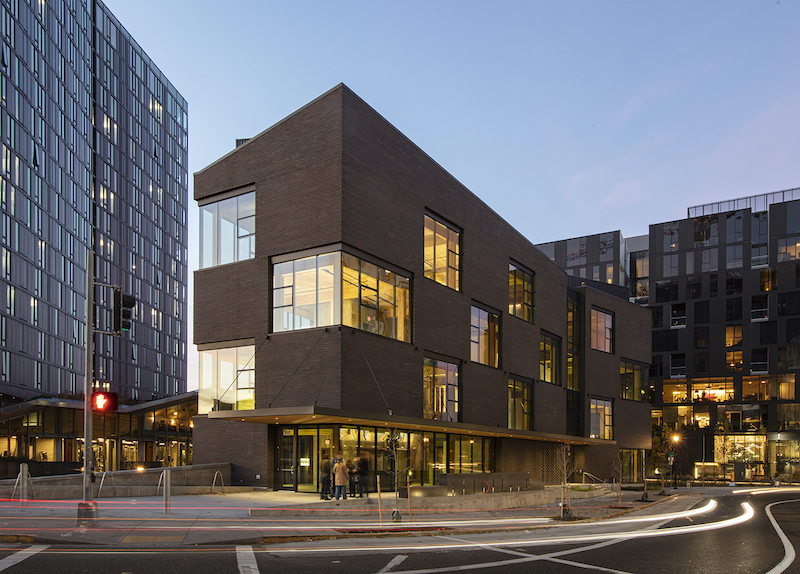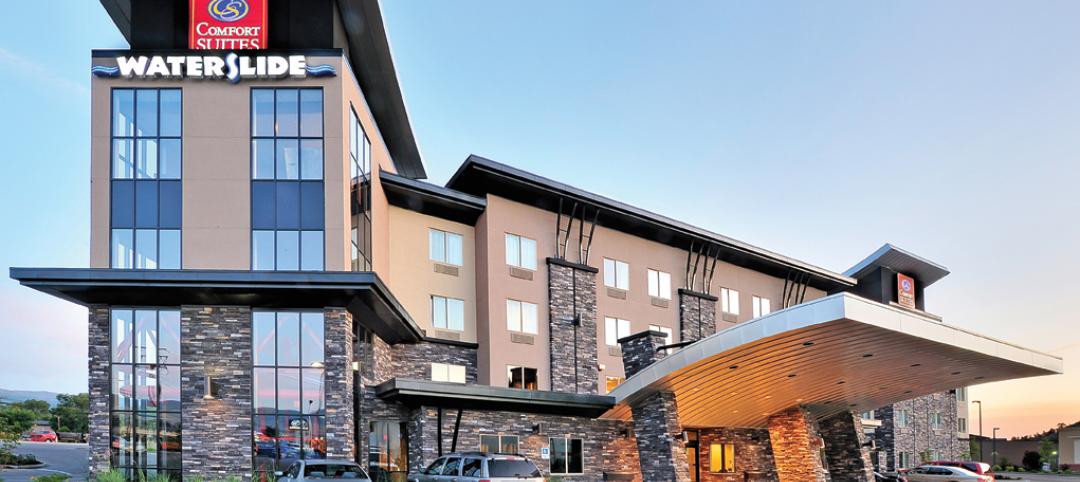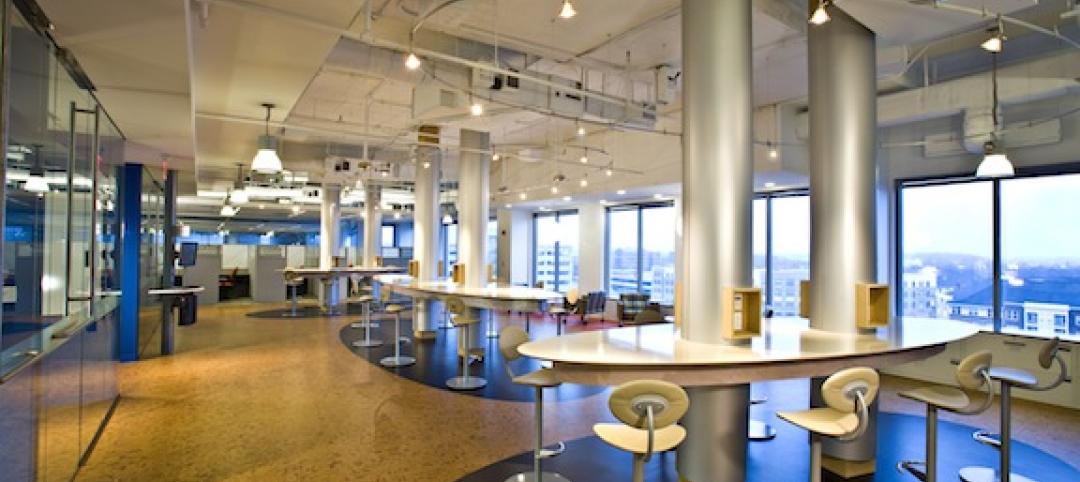Last year, contractors used mass timber to construct an estimated 78 buildings in the U.S., representing 4 million sf of space. A comprehensive new report on the North American mass timber market projects that the number of mass timber buildings could double every two years. By 2034, there would be new demand for 12.9 billion board feet of lumber that would require the establishment of nearly 77 million acres of new forestland.
The 156-page mass timber report—produced by The Beck Group, Forest Business Network, Treesource, and Kaiser + Path, a real estate developer/builder and architect—takes a deep dive into current and possible future supply and demand for mass timber components and panels for the U.S. and Canada. Its primary argument is that significant growth in the use of mass timber as a building material is achievable without serious deforestation. The report also justifies its forecasts about mass timber’s expanded use as a building product on the premise that the products would deliver myriad benefits, vis-a-vis other materials, to owners, builders, designers, occupants, and the environment.
(If mass timber use expands as predicted, the report contends that, by 2034, the North American building industry will store more carbon than it emits.)
Also see: Vermont’s Burr and Burton Academy expansion will feature mass timber and flexible spaces
WILL SUPPLY KEEP UP WITH MASS TIMBER DEMAND?
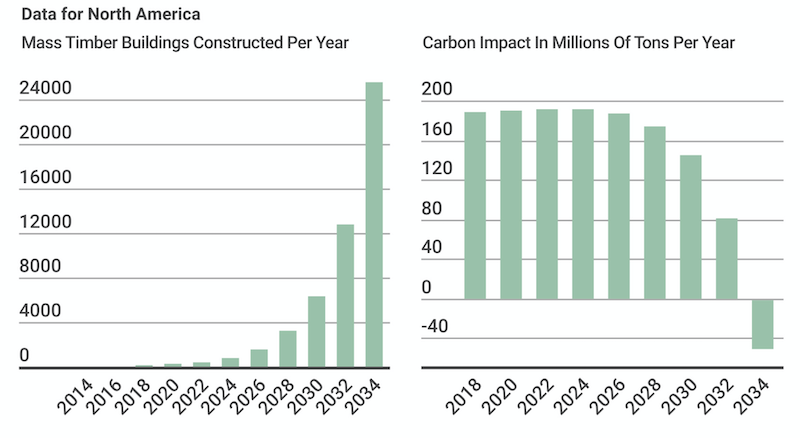
The number of mass timber buildings is expected to double every two years through 2034, at which point the construction industry would be storing more carbon than it emits. Charts and images: North American Mass Timber Report: 2020 State of the Industry
Some of the report’s assumptions rest on incomplete data. For example, when it discusses overharvesting, the report’s conclusions are drawn from so-called “growth to drain” estimates that, for the U.S., stop at the year 2012, and at 2016 for Canada, where the report says more active forest management is needed to make Canada’s lumber more resilient to climate change and infestation.
Nevertheless, the report places mass timber within the larger context of available construction materials. To produce a cubic foot of mass timber raw material requires about 22.5 board feet of lumber. The estimated demand for mass timber products last year was between 20 million and 25 million cubic feet. The 450-500 million board feet of softwood lumber consumed for North American mass timber in 2019 represented less that 1% of the total softwood lumber produced that year.
“Even if the lumber demand expands to 3 billion board feet per year (more than six times the current level), it would represent only a 5% share of today’s lumber production,” the report states. “The mass timber industry can expand several times its current size before it will make a significant impact on the North American lumber industry.” The report also believes the expansion of North American lumber capacity will help absorb new demand expected from increased mass timber construction.
Also see: Mass timber construction grows up
However, the report acknowledges that the industry’s capacity to produce mass timber is nowhere close yet to meeting future demand. For example, the report estimates that by 2034 North American buildings could consume 576 million cubic feet of mass timber panels annually. That means manufacturers would need to boost their current capacities by a factor of nearly 40 to meet those demand projections.
(That’s not inconceivable, though: the report notes that panel manufacturing capacity in North America increased by more than 1,000% between 2010 and 2020.)
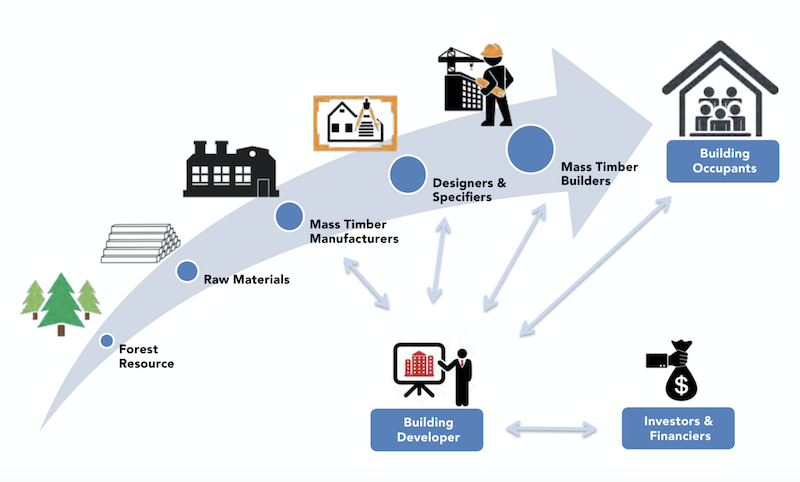
The current supply chain in North America needs to expand its production capacity to meet the mass timber demand projected by the report.
Manufacturer investment in new capacity is worth the risk, the report contends, given recent code changes that will allow the use of mass timber for buildings up to 18 stories, as well as efficiency improvements, government incentives and support, and product standardization. Mass timber can also burnish a supplier’s and owner’s environmental rep, as there’s an estimated 0.023 tons of carbon offset for every building that uses mass timber instead of steel or concrete; and 0.0047 net tons of carbon is sequestered by mass timber for every square foot of a building.
STILL A SLIVER OF NONRES CONSTRUCTION
Mass timber has a long road to hoe to make serious inroads into nonresidential construction, which currently accounts for only around 5% of mass timber consumption, versus 70-75% that’s consumed by homebuilding and residential renovation.
Cost remains a factor, as it’s still cheaper to use wood and concrete than cross-laminated timber (CLT) components to build with. (Lumber represents about half of the total production cost for cross-laminated timber, and operating costs for production range from $5-7 per cubic foot.)
Also see: More mass timber beam and column options available in the U.S.
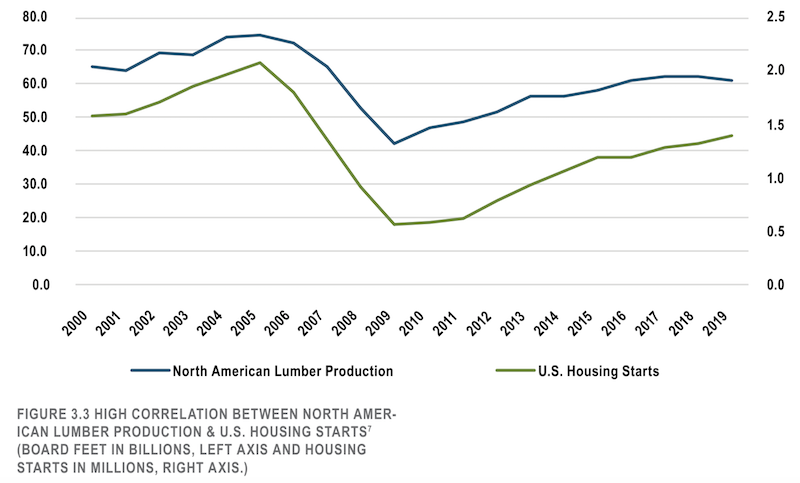
Homebuilding and renovation account for between 70-75% of the mass timber consumed annually. But the use of mass timber in nonresidential construction continues to grow.
But the nonresidential application of mass timber keeps growing. In Portland, Ore., an urban infill project completed in April called Sideyard—a 20,000-ft wedge-shaped building that reconnects a roadway to that city’s Burnside Bridge—features a new CLT structural system with an open ground-level commuter-oriented retail space that’s geared toward guests and tenants. The Building Team included Skylab (architect), Anderson Construction (GC), Harper Houf Peterson Righellis (CE), catean engineers (SE), and PAE (mechanical engineer). DR Johnson supplied the CLT panels and glulam members, and Freres Lumber supplied the mass plywood panels.
The report also points to Lendlease’s 50-year agreement to provide lodging for the U.S. Army. The contractor has built hotels on more than 40 installations and joint bases, including Redstone Arsenal in Alabama where Lendlease built with mass timber and completed the project 37% faster and with 44% fewer worker hours than the other hotels.
Mass timber demand is greatest in California, where there were 32 mass timber buildings completed and 68 in design as of 2019. The next closest states were Washington (28 built, 44 in design), and Texas (17 and 37). All told, there were 248 mass timber buildings completed and 460 in design in the U.S. by the end of last year.
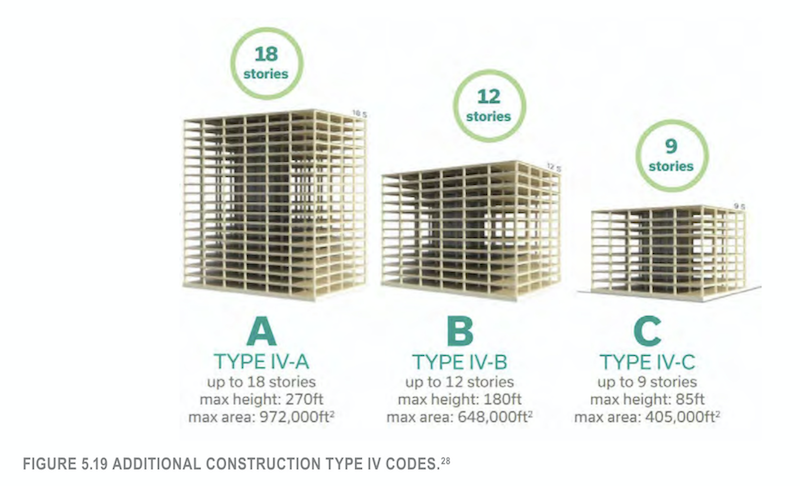
The International Code Council's 2021 building code would allow the use of mass timber in buildings up to 18 stories tall. Codes changes are one of the report's justifications for recommending that manufacturers invest in production capacity.
INSURERS ARE SKEPTICAL
The report claims that occupants in buildings made with mass timber benefit from better air quality and thermal comfort. (The report references research establishing links between wood and human health.) Owners might benefit as “the carbon impact of an investment will factor into market value,” as well as from reduced construction time and carrying costs, resilience (including seismic), and opportunities to reuse mass timber after demolition.
One caveat, the report notes, is that these and other benefits, such as better fire resistance, don’t always register with insurers that still tend to view all wood buildings similarly for liability risk.
Related Stories
| Dec 17, 2010
Subway entrance designed to exude Hollywood charm
The Hollywood/Vine Metro portal and public plaza in Los Angeles provides an entrance to the Red Line subway and the W Hollywood Hotel. Local architect Rios Clementi Hale Studio designed the portal and plaza to flow with the landmark theaters and plazas that surround it.
| Dec 17, 2010
Cladding Do’s and Don’ts
A veteran structural engineer offers expert advice on how to avoid problems with stone cladding and glass/aluminum cladding systems.
| Dec 7, 2010
USGBC: Wood-certification benchmarks fail to pass
The proposed Forest Certification Benchmark to determine when wood-certification groups would have their certification qualify for points in the LEED rating systemdid not pass the USGBC member ballot. As a result, the Certified Wood credit in LEED will remain as it is currently written. To date, only wood certified by the Forest Stewardship Council qualifies for a point in the LEED, while other organizations, such as the Sustainable Forestry Initiative, the Canadian Standards Association, and the American Tree Farm System, are excluded.
| Dec 7, 2010
Product of the Week: Petersen Aluminum’s column covers used in IBM’S new offices
IBM’s new offices at Dulles Station West in Herndon, Va., utilized Petersen’s PAC-1000 F Flush Series column covers. The columns are within the office’s Mobility Area, which is designed for a mobile workforce looking for quick in-and-out work space. The majority of workspaces in the office are unassigned and intended to be used on a temporary basis.
| Nov 11, 2010
Saint-Gobain to make $80 million investment in SAGE Electrochromics
Saint-Gobain, one of the world’s largest glass and construction material manufacturers, is making a strategic equity investment in SAGE Electrochromics to make electronically tintable “dynamic glass” an affordable, mass-market product, ushering in a new era of energy-saving buildings.
| Nov 11, 2010
Saint-Gobain to make $80 million investment in SAGE Electrochromics
Saint-Gobain, one of the world’s largest glass and construction material manufacturers, is making a strategic equity investment in SAGE Electrochromics to make electronically tintable “dynamic glass” an affordable, mass-market product, ushering in a new era of energy-saving buildings.
| Nov 5, 2010
New Millennium’s Gary Heasley on BIM, LEED, and the nonresidential market
Gary Heasley, president of New Millennium Building Systems, Fort Wayne, Ind., and EVP of its parent company, Steel Dynamics, Inc., tells BD+C’s Robert Cassidy about the Steel Joist Manufacturer’s westward expansion, its push to create BIM tools for its products, LEED, and the outlook for the nonresidential construction market.
| Nov 3, 2010
Sailing center sets course for energy efficiency, sustainability
The Milwaukee (Wis.) Community Sailing Center’s new facility on Lake Michigan counts a geothermal heating and cooling system among its sustainable features. The facility was designed for the nonprofit instructional sailing organization with energy efficiency and low operating costs in mind.
| Nov 2, 2010
11 Tips for Breathing New Life into Old Office Spaces
A slowdown in new construction has firms focusing on office reconstruction and interior renovations. Three experts from Hixson Architecture Engineering Interiors offer 11 tips for office renovation success. Tip #1: Check the landscaping.
| Nov 2, 2010
Cypress Siding Helps Nature Center Look its Part
The Trinity River Audubon Center, which sits within a 6,000-acre forest just outside Dallas, utilizes sustainable materials that help the $12.5 million nature center fit its wooded setting and put it on a path to earning LEED Gold.


